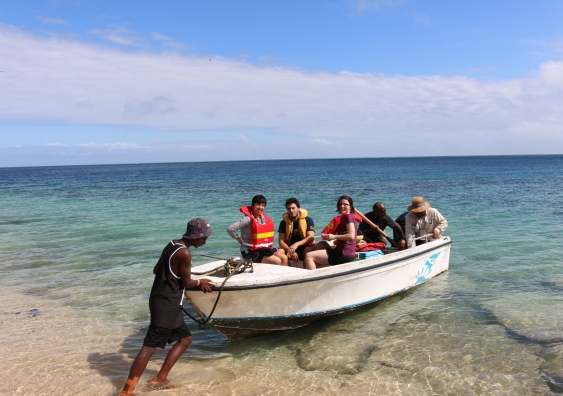Northern exposure
What does it mean to be an engineer? Four students found the answer in the Torres Strait, as part of an innovative course that is transforming lives. 
What does it mean to be an engineer? Four students found the answer in the Torres Strait, as part of an innovative course that is transforming lives. 

Mer Island, a small dot in the Torres Strait, halfway between Cape York and Papua New Guinea, is about as remote as you can get and still be part of Australia.
ÔÇ£From Sydney youÔÇÖll get a cheaper ticket to London than you will get to [Mer],ÔÇØ says Professor Martin Nakata, director of the Nura Gili Centre for Indigenous Programs.
For a group of final-year engineering students, the chance to travel to the island was a once-in-a-lifetime adventure ÔÇô not just to explore the Torres Strait but because the island, also known as Murray Island, was the home of Eddie Mabo, the architect of AustraliaÔÇÖs modern land rights movement.
The trip gave us a better understanding of the intricacies and sensitivity that being an engineer involves.
The purpose of the trip was to take part in an innovative teaching program designed to motivate and inspire students to think differently about what it means to be an engineer.
ÔÇ£It was the most unbelievable experience. What we learned, above all else, is that engineering does not exist in a vacuum; it is and has to be a reaction to the social and cultural environment it is serving,ÔÇØ says student Sarah Hayes.
The group was challenged through a design competition to consider ways to improve the quality of life for the 450-strong community, which relies on diesel for electricity, desalination for water supply and waste disposal via landfill and burning off.
Their ideas won a showcase event hosted by Nura Gili at the end of first semester 2015 and attended by more than 170 industry, academic, university and high-school students.
ÔÇ£And so it was that the four of us came to spend a week in the most remote and beautiful place we had ever seen,ÔÇØ Hayes says.
The program, part of the ÔÇÿPlanning Sustainable InfrastructureÔÇÖ course, has received accolades for its ability to foster engagement with community and business, and its cross-faculty approach to teaching that brings together the School of Civil and Environmental Engineering and Nura Gili.
Nakata says the course strives to help students understand how historical, cultural and environmental contexts impact design decisions.
ÔÇ£We wanted to give the students immersion in a situation that would break the propensity to just deploy technological answers and instead encourage them to create solutions that are meaningful for the community,ÔÇØ he says.

The approach won the Australasian Association for Engineering Education 2015 Award for ÔÇÿExcellence in Engineering Education EngagementÔÇÖ and a ║┌┴¤═°┤¾╩┬╝à Vice-ChancellorÔÇÖs Award for Teaching Excellence for team leader Stephen Moore, and team members, Nakata, Professor Richard Stuetz, Associate Professor Iain MacGill, Dr Taha Rashidi, Ruth Fisher and Elsie Edgerton-Till.
Moore and Stuetz said the intention was never to give advice to the community, but rather help students understand the importance of the planning phase in infrastructure projects.
ÔÇ£ItÔÇÖs about exposing students to a real situation,ÔÇØ says Stuetz. ÔÇ£WeÔÇÖve been really fortunate to have the opportunity to work with Martin [Nakata] to bring social awareness and a particular focus on Indigenous understanding to the course.ÔÇØ
As part of the collaboration Mer IslandÔÇÖs Doug Passi and other community members travelled to ║┌┴¤═°┤¾╩┬╝à to share the communityÔÇÖs history, including the historic Mabo land rights case, and give students an insight into the communityÔÇÖs current concerns.
The studentsÔÇÖ visit has sparked a two-way dialogue about more sustainable infrastructure development opportunities on the island and the desire to strengthen the relationship with ║┌┴¤═°┤¾╩┬╝Ã.
Says Hayes: ÔÇ£The trip gave us a better understanding of the intricacies and sensitivity that being an engineer involves, and that will be valuable to us for the rest of our lives.ÔÇØ
For the full list of 2015 Vice-Chancellor's Award winners, go to .